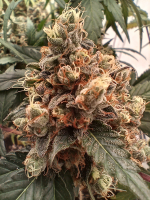Very informative thread 

Can't contribute much to the thread other than sharing my experience.
Years ago i purchased my first led light when they became a thing but it was a very bad experience. It was blurple light, had 300W power outdraw, cost me 500 bucks, created a hot spot, wasn't much cooler than using hps with an adjust-a-wing reflector and couldn't compete with it in any way despite the advertising.
So this time i wanted to make it right when investing so much money and did a lot of research before my purchase.
My brand of choice is Spider Farmer. Their SE 5000 model with 480W is what i use for late veg and flowering all year round. Really like the stepless knob for the power draw and that i can put the power supply outside the box in summer and inside again in the winter to blow a fan on it and gain some degrees.
The results are also working for me and that's why i got a Spider Farmer SE 3000 (300W) for my veg/mother room to replace the Viparspectra P1000 (100W) for now and maybe using it for smaller projects in the future.
Is Spider Farmer the best? Probably not and i don't know but i got my money worth.
Hope this helps somebody in any way and maybe i should mention that the Spider Farmer Halloween Sale will end today and that i am in no way connected to them, just a happy customer

Attached some older pictures
Can't contribute much to the thread other than sharing my experience.
Years ago i purchased my first led light when they became a thing but it was a very bad experience. It was blurple light, had 300W power outdraw, cost me 500 bucks, created a hot spot, wasn't much cooler than using hps with an adjust-a-wing reflector and couldn't compete with it in any way despite the advertising.
So this time i wanted to make it right when investing so much money and did a lot of research before my purchase.
My brand of choice is Spider Farmer. Their SE 5000 model with 480W is what i use for late veg and flowering all year round. Really like the stepless knob for the power draw and that i can put the power supply outside the box in summer and inside again in the winter to blow a fan on it and gain some degrees.
The results are also working for me and that's why i got a Spider Farmer SE 3000 (300W) for my veg/mother room to replace the Viparspectra P1000 (100W) for now and maybe using it for smaller projects in the future.
Is Spider Farmer the best? Probably not and i don't know but i got my money worth.
Hope this helps somebody in any way and maybe i should mention that the Spider Farmer Halloween Sale will end today and that i am in no way connected to them, just a happy customer

Attached some older pictures



 will be sure to add this to the choices and future comparisons
will be sure to add this to the choices and future comparisons





